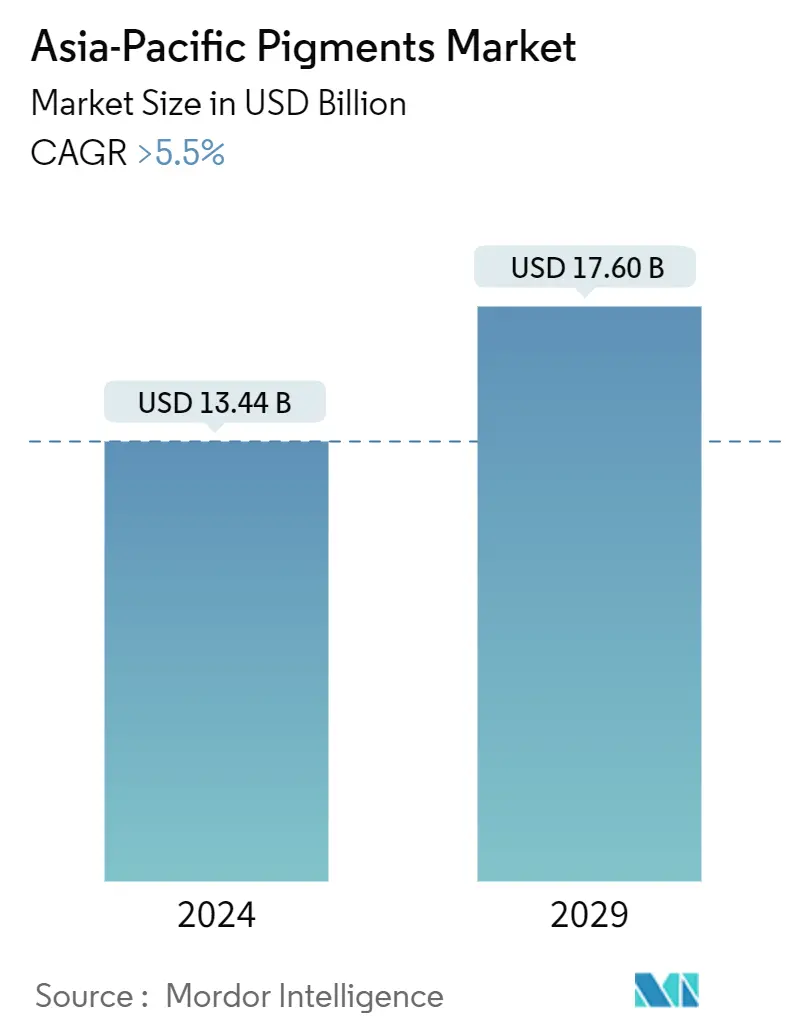Market Size of Asia-Pacific Pigments Industry

| Study Period | 2019-2029 |
| Base Year For Estimation | 2023 |
| Market Size (2024) | USD 13.44 Billion |
| Market Size (2029) | USD 17.60 Billion |
| CAGR (2024 - 2029) | > 5.50 % |
| Market Concentration | High |
Major Players
*Disclaimer: Major Players sorted in no particular order |
Asia Pacific Pigments Market Analysis
The Asia-Pacific Pigments Market size is estimated at USD 13.44 billion in 2024, and is expected to reach USD 17.60 billion by 2029, growing at a CAGR of greater than 5.5% during the forecast period (2024-2029).
- The Asia-Pacific pigments market was negatively affected by the COVID-19 pandemic. Countries like China, Japan, and India were worst hit by the COVID-19 pandemic in the region. The COVID pandemic resulted in lockdowns in these countries, thereby affecting the paints and coatings, textiles, and printing inks, thus affecting the pigment market. However, the market recovered well after the restrictions were lifted. Recently, the market registered a significant growth rate due to rising demand for pigments in paints and coatings and textile applications.
- The growing demand from the paints and coatings industry, increasing demand from the textile industry, and the increasing demand for pigments from plastics applications are expected to drive the market.
- The stringent government regulations on the usage of pigments are expected to hinder market growth.
- The shifting focus toward eco-friendly products is expected to create opportunities for the market during the forecast period.
- China is expected to dominate the market due to the rising demand for pigments in paints, coatings, and textiles applications. It is also expected to register the highest CAGR during the forecast period.
Asia Pacific Pigments Industry Segmentation
Pigments are molecules or substances that absorb specific wavelengths of visible light to produce a particular hue. Pigments can be found in paintings, inks, cosmetics, and other items. Pigments are found in various products and services associated with coloring materials and related technology. Pigments are used in various sectors, including coatings, plastics, printing inks, building, paper, leather, and cosmetics. Organic and inorganic pigments are available, with organic pigments being the most commonly used.
The market is segmented by product type, application, and geography. The market is segmented by product type into inorganic (titanium dioxide, zinc oxide, and other inorganic product types such as iron oxide, chromium oxide, etc.), organic, specialty pigments, and other product types like metallic pigments, natural pigments, etc. By application, the market is segmented into paints and coatings, textiles, printing inks, plastics, leather, and other applications such as cosmetics, ceramics, electronics, etc. The report also covers the market size and forecasts for the Asia-Pacific pigments market for five major countries.
For each segment, the market sizing and forecasts are based on value (USD).
| Product Type | |||||
| |||||
| Organic | |||||
| Specialty Pigments | |||||
| Other Product Types (Metallic Pigments, Natural Pigments, etc.) |
| Application | |
| Paints and Coatings | |
| Textiles | |
| Printing Inks | |
| Plastics | |
| Leather | |
| Other Applications (Cosmetics, Ceramics, Electronics, etc.) |
| Geography | |
| China | |
| India | |
| Japan | |
| South Korea | |
| Australia & New Zealand | |
| Rest of Asia-Pacific |
Asia-Pacific Pigments Market Size Summary
The Asia-Pacific pigments market is poised for significant growth, driven by increasing demand from the paints and coatings, textile, and plastics industries. The market experienced a downturn due to the COVID-19 pandemic, which led to lockdowns in key countries such as China, Japan, and India, impacting sectors like paints, coatings, textiles, and printing inks. However, the market has shown resilience and is on a recovery path, with China expected to lead the growth due to its robust demand in these sectors. The region's paints and coatings industry, particularly in China, India, and South Korea, is witnessing increased demand from the construction and automotive sectors, further propelling the pigments market. Despite challenges posed by stringent government regulations, the shift towards eco-friendly products presents new opportunities for market expansion.
China stands out as a dominant force in the Asia-Pacific pigments market, with significant contributions from its construction, automotive, and textile industries. The country's construction sector is one of the largest in the region, with substantial investments expected in residential and commercial projects. The automotive industry in China is also evolving, with a notable shift towards electric vehicles, which is anticipated to boost the demand for automotive coatings. Additionally, China's textile industry continues to grow, maintaining its position as a leading global exporter. The plastics industry in China is expanding due to rising demand for engineering plastics, further supporting the pigments market. The market is consolidated, with key players like BASF SE, DIC Corporation, and Venator Materials PLC actively shaping the competitive landscape through strategic acquisitions and partnerships.
Asia-Pacific Pigments Market Size - Table of Contents
-
1. MARKET DYNAMICS
-
1.1 Drivers
-
1.1.1 Growing Demand From the Paints and Coatings Industry
-
1.1.2 Rising Demand from the Textile Industry
-
1.1.3 The Increasing Demand for Pigments from Plastics Applications
-
-
1.2 Restraints
-
1.2.1 Stringent Government Regulations on the usage of Pigments
-
1.2.2 High Cost Associated with the Organic Pigments
-
-
1.3 Industry Value Chain Analysis
-
1.4 Porter's Five Forces Analysis
-
1.4.1 Bargaining Power of Suppliers
-
1.4.2 Bargaining Power of Buyers
-
1.4.3 Threat of New Entrants
-
1.4.4 Threat of Substitute Products and Services
-
1.4.5 Degree of Competition
-
-
-
2. MARKET SEGMENTATION (Market Size in Value)
-
2.1 Product Type
-
2.1.1 Inorganic
-
2.1.1.1 Titanium Dioxide
-
2.1.1.2 Zinc Oxide
-
2.1.1.3 Other Inorganic Product Types (Iron Oxide, Chromium Oxide, etc.)
-
-
2.1.2 Organic
-
2.1.3 Specialty Pigments
-
2.1.4 Other Product Types (Metallic Pigments, Natural Pigments, etc.)
-
-
2.2 Application
-
2.2.1 Paints and Coatings
-
2.2.2 Textiles
-
2.2.3 Printing Inks
-
2.2.4 Plastics
-
2.2.5 Leather
-
2.2.6 Other Applications (Cosmetics, Ceramics, Electronics, etc.)
-
-
2.3 Geography
-
2.3.1 China
-
2.3.2 India
-
2.3.3 Japan
-
2.3.4 South Korea
-
2.3.5 Australia & New Zealand
-
2.3.6 Rest of Asia-Pacific
-
-
Asia-Pacific Pigments Market Size FAQs
How big is the Asia-Pacific Pigments Market?
The Asia-Pacific Pigments Market size is expected to reach USD 13.44 billion in 2024 and grow at a CAGR of greater than 5.5% to reach USD 17.60 billion by 2029.
What is the current Asia-Pacific Pigments Market size?
In 2024, the Asia-Pacific Pigments Market size is expected to reach USD 13.44 billion.

